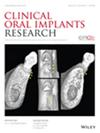In Vitro Assessment of the Potential Effect of Vertical Peri-Implant Soft Tissue Thickness on Nonsurgical and Surgical Implant Surface Decontamination Methods
Abstract
Objectives
In vitro analysis of the influence of vertical peri-implant soft tissue thickness (STT) on nonsurgical and surgical implant surface decontamination efficacy.
Material and Methods
A total of 360 implants were dipped in indelible color to imitate biofilm contamination, distributed to 30°, 60° or 90° angulated bone defect models and in subgroups of 40 assigned to a decontamination method (CUR: curette; SOSC: soundscaler; APA: air powder abrasion). Of these, 20 were subjected to a simulated STT of 1.5 or 3.0 mm, of which 10 were cleaned within a nonsurgical (NST) or surgical (ST) treatment. Uncleaned implant surface was determined by photographs. Surface changes were assessed using scanning electron micrographs (SEM).
Results
The overall cleaning efficacy decreased significantly (APA > SOSC > CUR, p < 0.001). Cleaning efficacy failed to show a significant difference between both STTs (STT1.5: 63.68%, STT3.0: 63.26%; p = 0.877). Within respective STT, cleaning efficacy differed depending on the method and the approach (STT1.5: CUR: p = 0.169, SOSC: p = 0.004, APA: p < 0.001; STT3.0: CUR p < 0.001, SOSC: p < 0.001, APA: p < 0.001; STT1.5/NST, CUR: 82.34%, SOSC: 74.98%, APA: 93.60%; STT1.5/ST, CUR: 79.85%, SOSC: 65.37%, APA: 50.12%; STT3.0/NST, CUR: 83.19%, SOSC: 70.85%, APA: 92.31%; STT3.0/ST, CUR: 80.00%, SOSC: 64.61%, APA: 46.49%). Analysis of variance revealed significant associations of color remnants with the approach, the method used, and the defect angulation (p < 0.001). SEMs showed less surface damages after use of APA.
Conclusions
In this In Vitro study no statistically significant influence of STT on the efficacy of surface decontamination could be detected. Treatment method, defect angle and approach were confirmed as predictors for the cleaning efficacy.


 求助内容:
求助内容: 应助结果提醒方式:
应助结果提醒方式:


